Between the two nights spent in a hotel in the city of Khon Kaen in eastern Thailand, I went on a day trip by renting a car with a driver. As I’ve mentioned in the previous sequel of my story, it was essentially a taxi and the driver was, in fact, a female. It was all the same to me, but it was good.
After visiting two significant and interesting temples in the city and its immediate surroundings, the plan was to head to the northeast of the country, with the main destination being the town of Ban Chiang, which is about 150 km and over 2 hours’ drive away from Khon Kaen.
Here is the map again, showing the places I visited during the month spent in Thailand and both of these towns can be found there.
However, in order to get on the right road, we passed by a junction near the city and there I saw – dinosaurs.
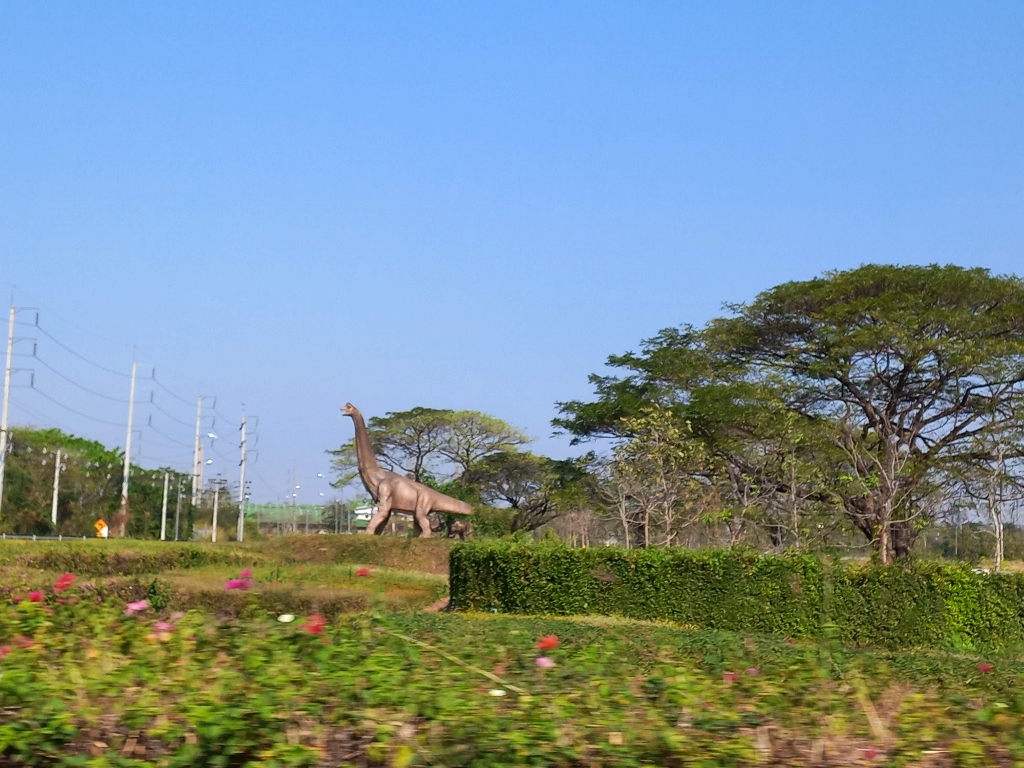 Dinosaur in the city of Khon Kaen
Dinosaur in the city of Khon Kaen
I was a bit confused, but later I found information that within a national park northwest of Khon Kaen, there is a park with over a hundred figures of dinosaurs that have been found in the northeast of Thailand since 1976. Since Khon Kaen is the capital of the province of the same name and the park with the dinosaurs is located in that province, it is clear that the local residents are proud of the fossils discovered in their region.
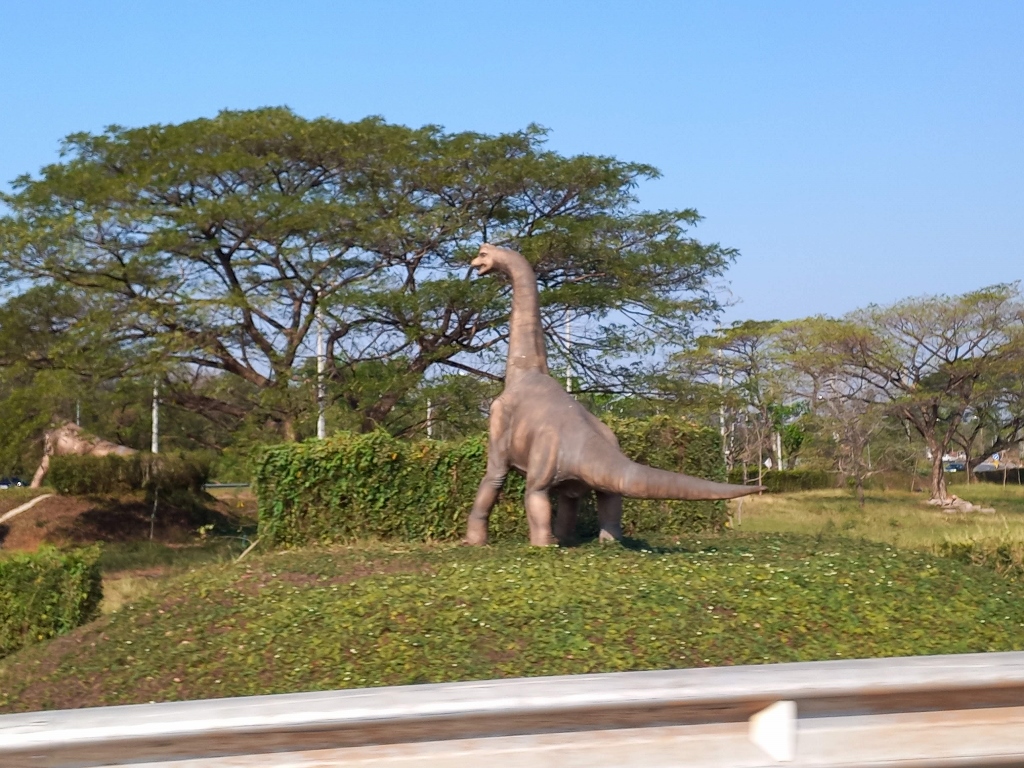 Dinosaur in the city of Khon Kaen
Dinosaur in the city of Khon Kaen
And then we set off towards Ban Chiang...
Along the way, I looked at the landscapes through which I was travelling – it was the very end of February, almost the end of the dry season, and although there was certainly vegetation, I’m sure everything would be much more lush and greener in other periods of the year.
I also observed the roads we travelled. I’ve mentioned before that I was impressed with the roads in Thailand. Perhaps the main reason for this are the stories about Thailand being a cheap destination for Western tourists, which created incorrect expectations and prejudices for me. However, I was very willing to adjust my opinion to reality.
 Road infrastructure in a smaller town
Road infrastructure in a smaller town
What is practically nonexistent outside Bangkok and some larger cities are grade-separated junctions. If you want to turn right on a road with multiple lanes, for example, while in Thailand, they drive on the left side, you have to first make a U-turn at the designated location and then return to the junction where you need to turn.
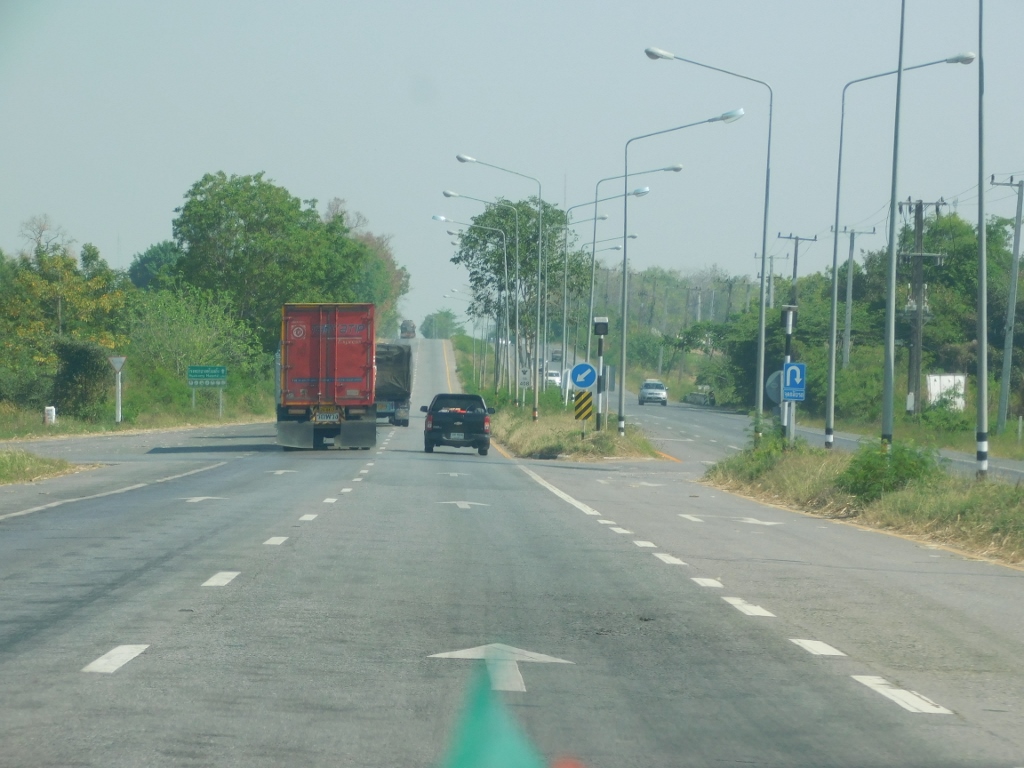 Lane for the U-turn is all the way to the right
Lane for the U-turn is all the way to the right
I also thought about all sorts of things during the journey. Among others, I thought about how, while travelling, especially by bus, train or car, there are so many details, small things that are specific, interesting, picturesque, that I come across suddenly and pass by, of course, without even having the chance to take a photo, which may not be the most important thing anyway. Because if I were to post all of that on my blog, there would be 100 instalments just to cover various details that catch my eye while travelling. I thought about how many people travel and look at their phones, or listen to music, or sleep, or whatever... All of that can be done at home. When travelling, one should look with wide-open eyes, mind and soul. Observe and pay attention to every detail, because there are so many interesting things. Of course, they are all forgotten over time on a conscious level, but I am convinced that they stay somewhere in the soul and change us. Some, honestly, are not very important, like a gas station, for example, but even power cables on poles can be interesting if we see them as different from ours and as a part of local habits and culture. It could be a bird on a wire, or fields prepared for planting, or fields with new, young rice... All in all, all of this stays within us and as much as we forget specific details, little things and the like, it fulfils us, fills us with knowledge, experience, images and it’s not all reduced to 0 or 1, i.e., to the binary system.
Well, that’s what I was thinking about, as I drove by car to Ban Chiang.
I suggested to the woman who was driving me that we stopped somewhere for lunch where she thought the food was good, and then she chose a restaurant beside the road.
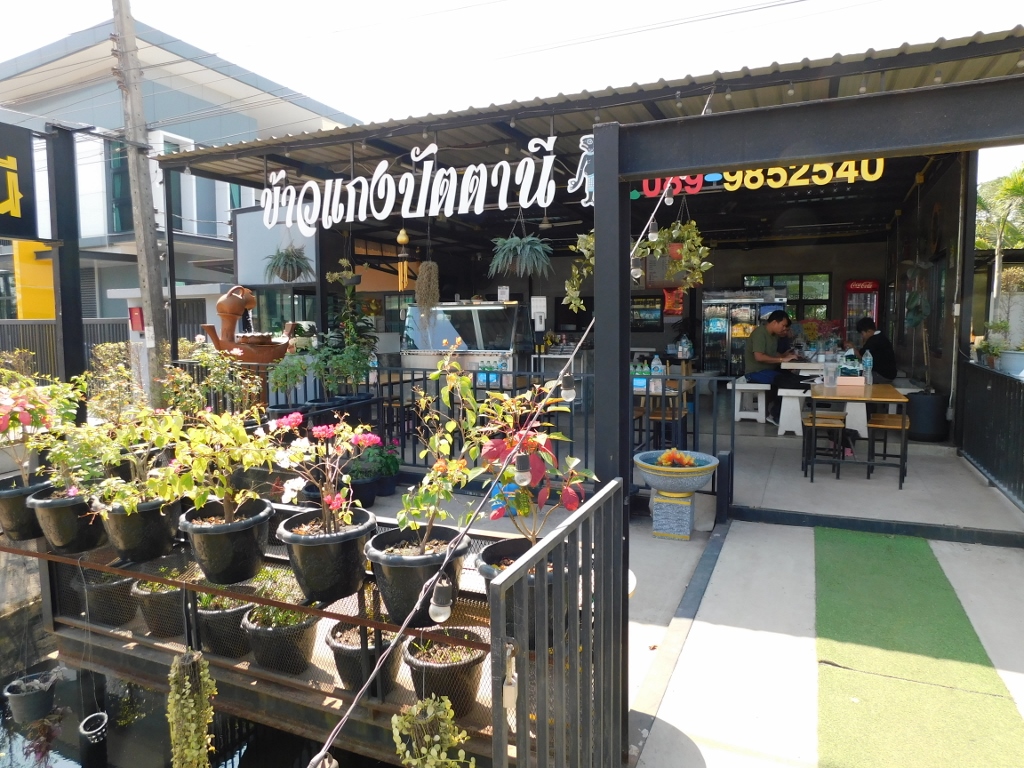 Restaurant by the road
Restaurant by the road
Here, the prepared dishes were already displayed and it was enough to just point out what you wanted to eat. That’s how I did it, at least. The woman who was driving me could also say what she wanted to eat. And the selection was quite nice.
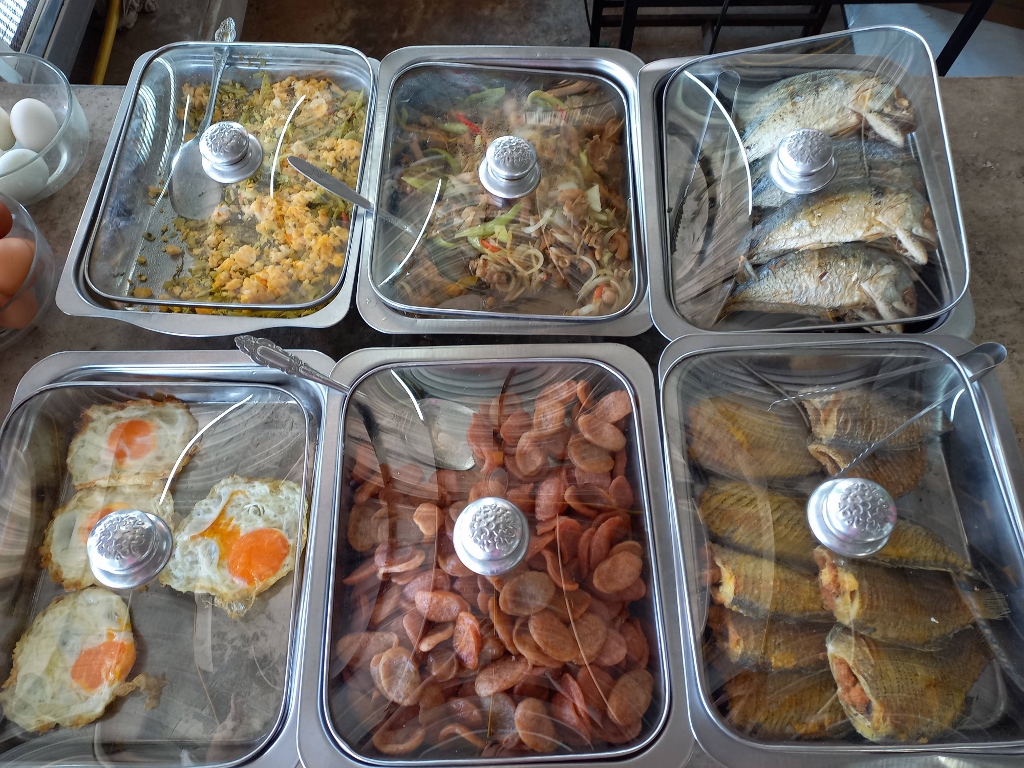 Food in the restaurant by the road
Food in the restaurant by the road
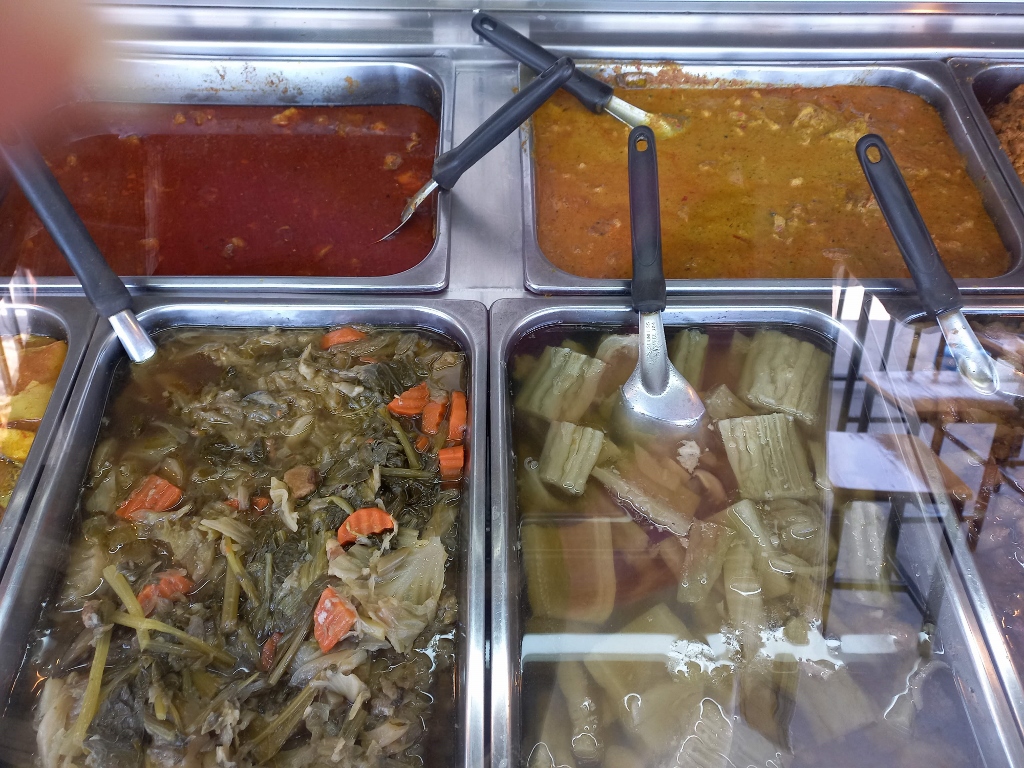 Food in the restaurant by the road
Food in the restaurant by the road
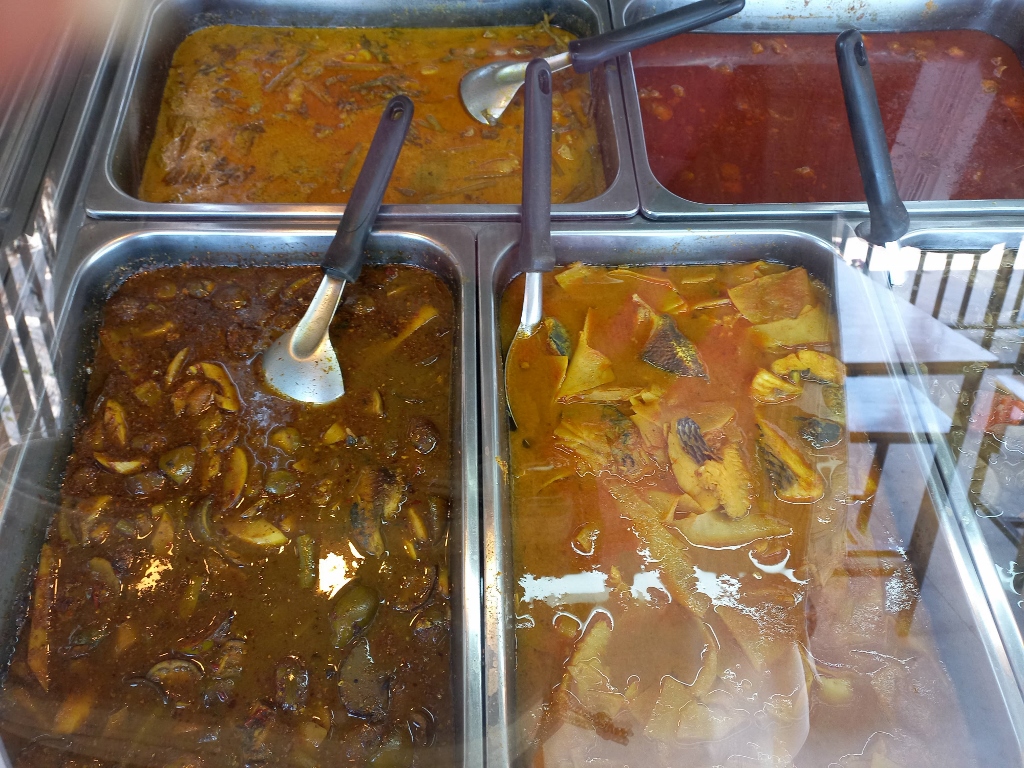 Food in the restaurant by the road
Food in the restaurant by the road
I did choose what I wanted, but my driver was kind enough to offer me something from what she had chosen, thinking it would be interesting for me to try. Everything was very tasty.
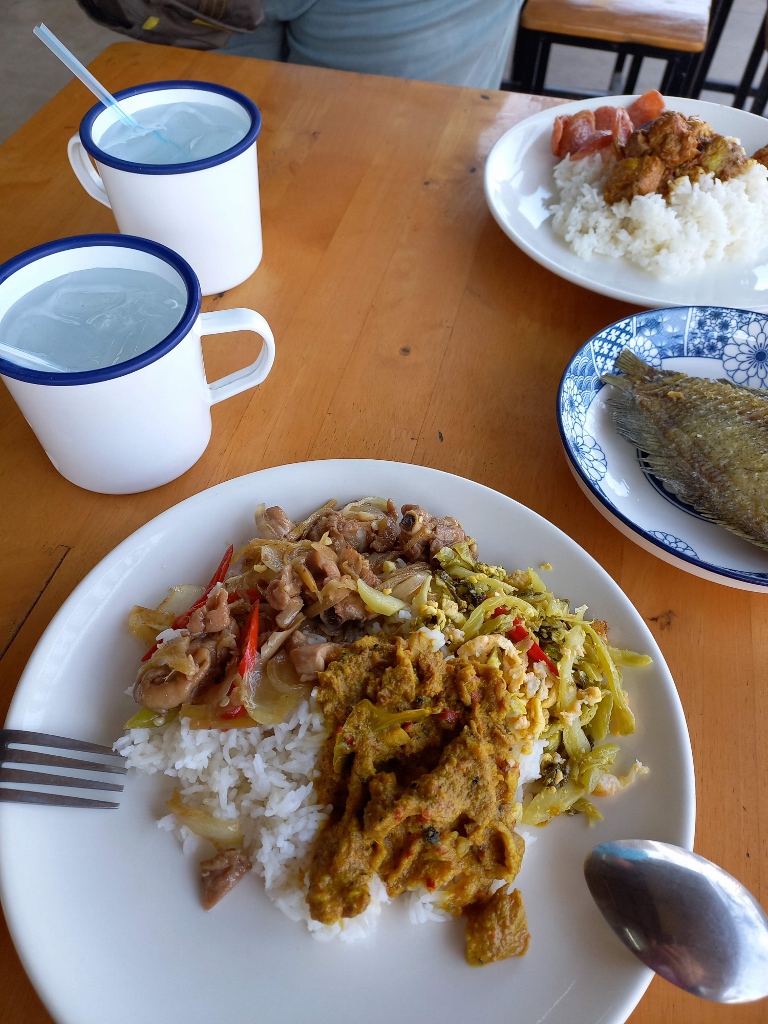 My lunch on the way to Ban Chiang
My lunch on the way to Ban Chiang
After lunch, we simply continued on our way and, in about an hour, we reached the village of Ban Chiang.
The village of Ban Chiang is located approximately 600 km northeast of Bangkok, and it’s not a very popular destination among tourists. However, it is actually of great significance. Namely, it is home to an archaeological site that is currently the earliest known centre for the production of copper and bronze objects in Southeast Asia. It is also considered the most important prehistoric settlement in this part of the world. Discoveries at this site provide evidence of significant cultural and social development, as well as agricultural production and the use of metal in crafting various items. However, it is the pottery decorated with red paint that is most commonly associated with this site.
The site was discovered in 1966 and the research has shown that there was a human settlement with burial sites here since the Bronze Age, from around 3600 to about 1000 BCE. In addition to being crucial for the reasons mentioned earlier, the site is also the richest in Southeast Asia in terms of the number and diversity of the artefacts unearthed here. Due to all these factors, the Ban Chiang archaeological site is listed on the UNESCO World Heritage List.
Much of this can surely be well observed at the National Museum of Ban Chiang when the museum is open. The museum is closed on Mondays and Tuesdays and, unfortunately, it was a Tuesday when I arrived here. I simply couldn’t fit a visit to this part of Thailand into my travel plans on any other day.
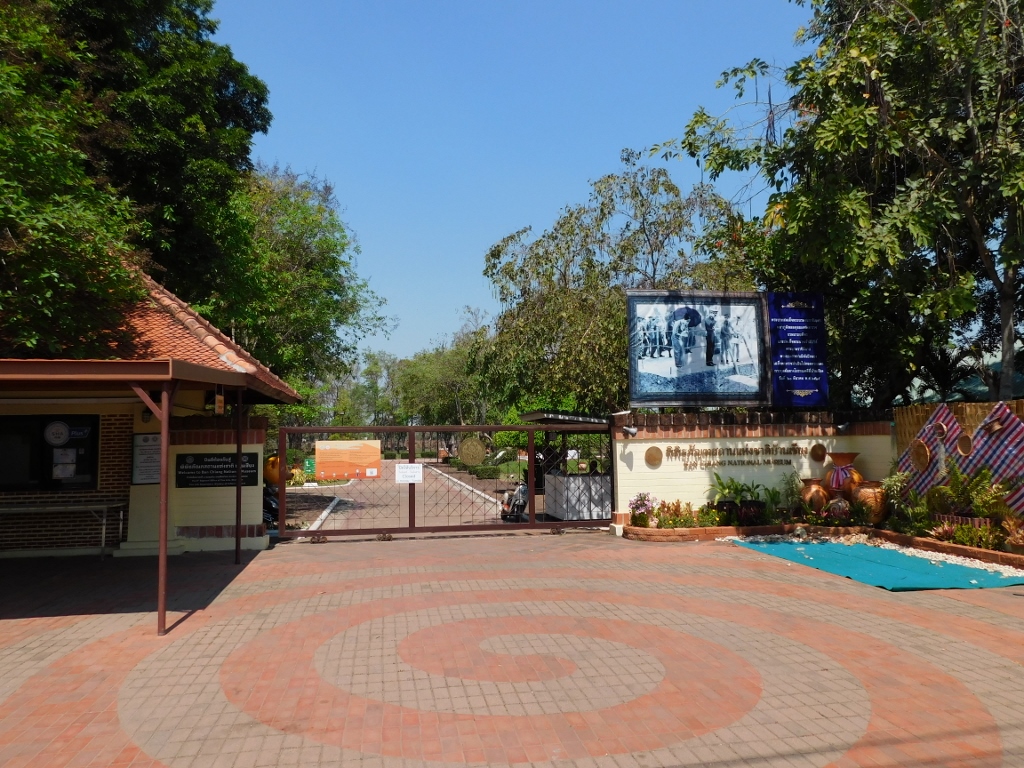 Closed gates of the National Museum of Ban Chiang
Closed gates of the National Museum of Ban Chiang
On the other hand, I knew that about 700 metres from the museum, there was an open archaeological site where some burial grounds were discovered. So, I consoled myself with the hope that I would still be able to see something and that’s why I decided to come here in the first place. Now, I started a leisurely walk through the village.
Right next to the museum, there is also a small lake.
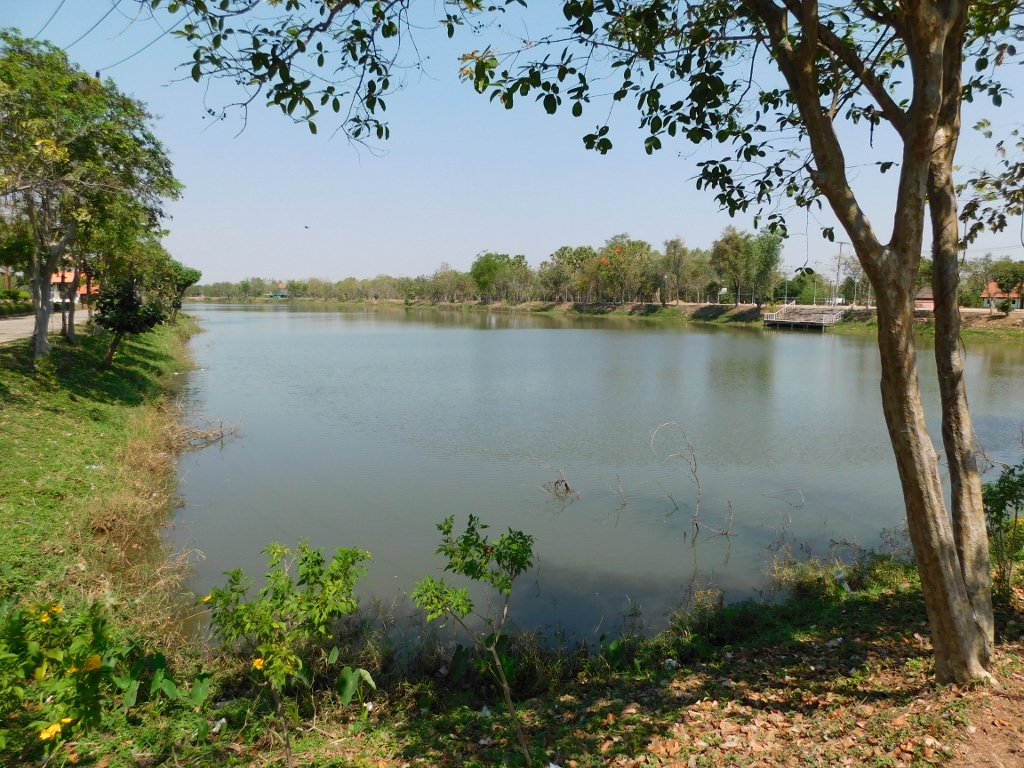 Ban Chiang village, a detail
Ban Chiang village, a detail
Across the street from the museum and the lake, there is a row of shops selling souvenirs. You can find a variety of items here, from clothing to toys for children, but the main focus is on replicas of the ceramic vessels found at the site.
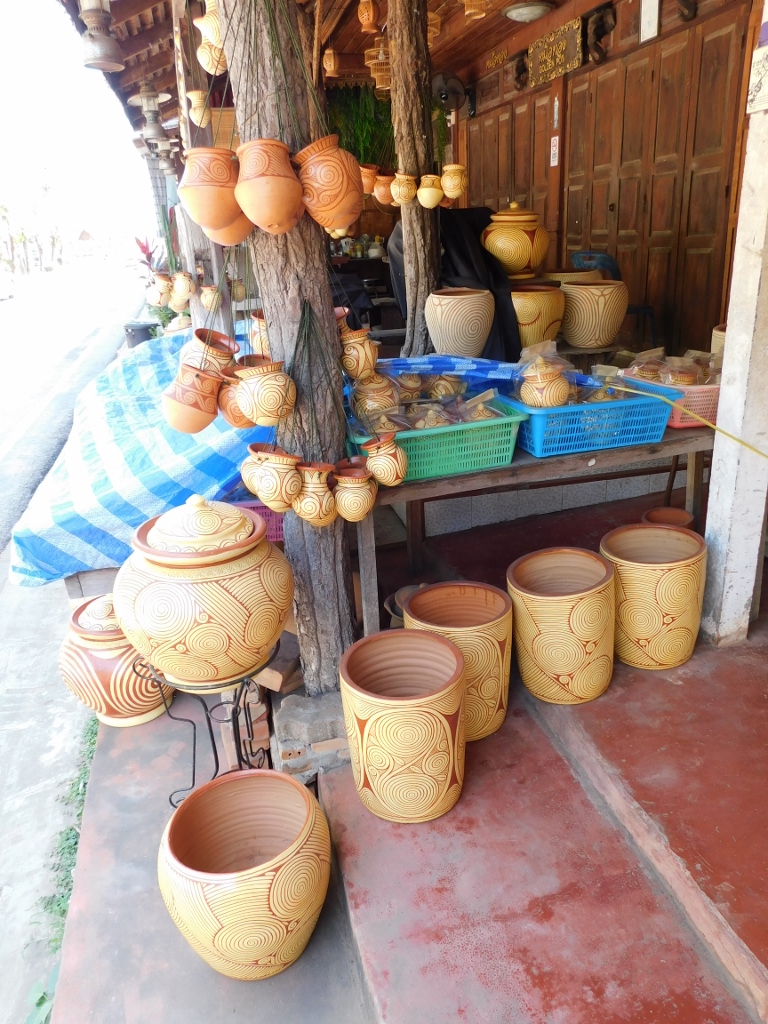 Ban Chiang village, a detail
Ban Chiang village, a detail
Even though I was primarily focused on reaching my desired destination, I couldn’t help but notice some details from the houses I passed by. For instance, there was a woman resting in her home. It felt a bit uncomfortable to take a photo because I felt like I was peeking into someone’s home, but in reality, everything was wide open, and it was impossible not to see simply by walking along the sidewalk. So, in the end, I did take a picture.
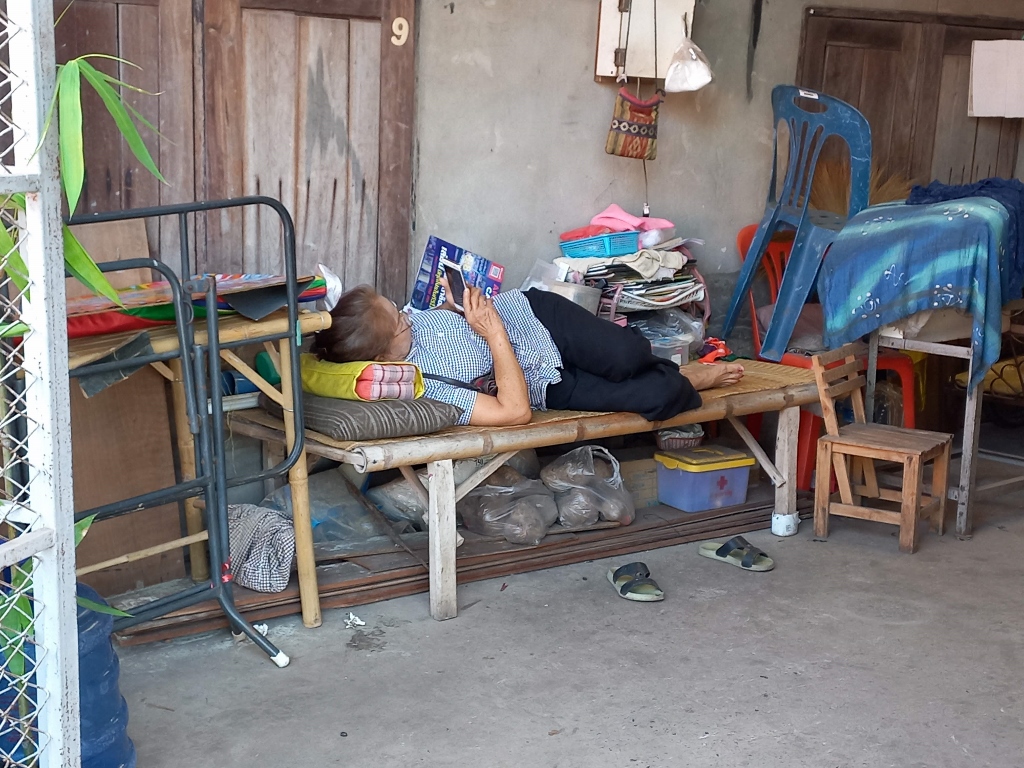 Ban Chiang village, a detail
Ban Chiang village, a detail
Soon I arrived at the site where the archaeological remains are and where the entrance fee is paid. I mention this not because of the ticket or the payment itself, but to convey that it is an official place for tourist visits. It is organised as a small open-air museum and the name of this place, Wat Pho Si Nai, is derived from the name of the temple also located within that area.
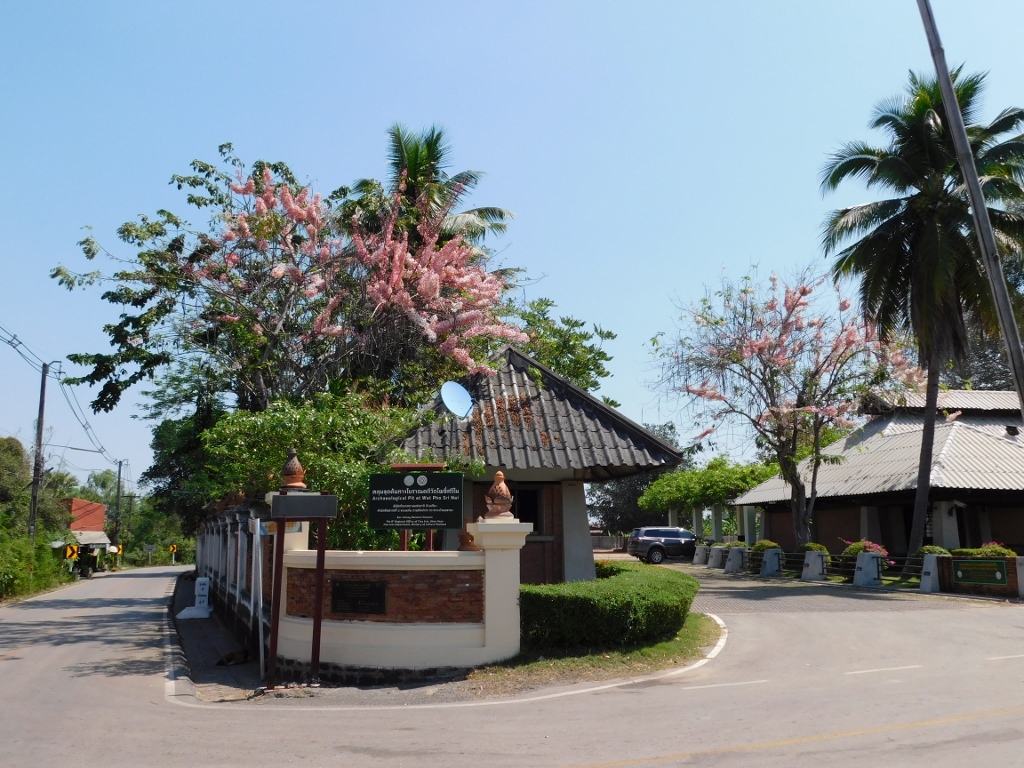 Ban Chiang village, entrance to the area with the archaeological site and the temple
Ban Chiang village, entrance to the area with the archaeological site and the temple
To start with, I was first amazed by the blossoms on a tree that grows here and then I started my sightseeing.
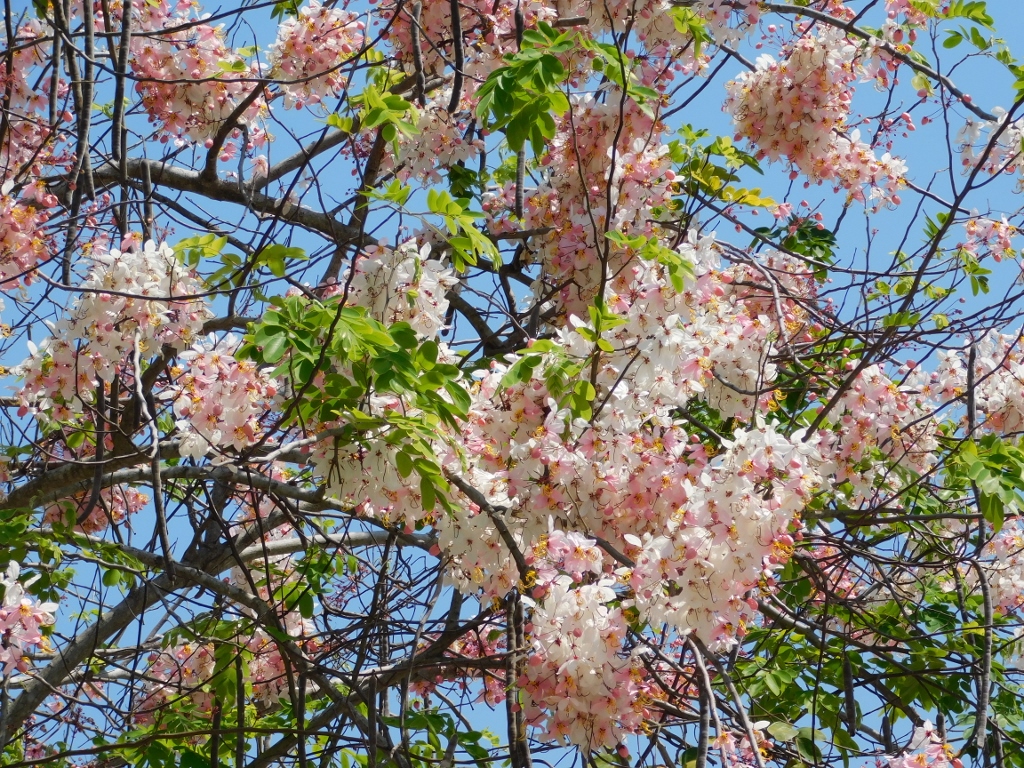 Ban Chiang village, a detail
Ban Chiang village, a detail
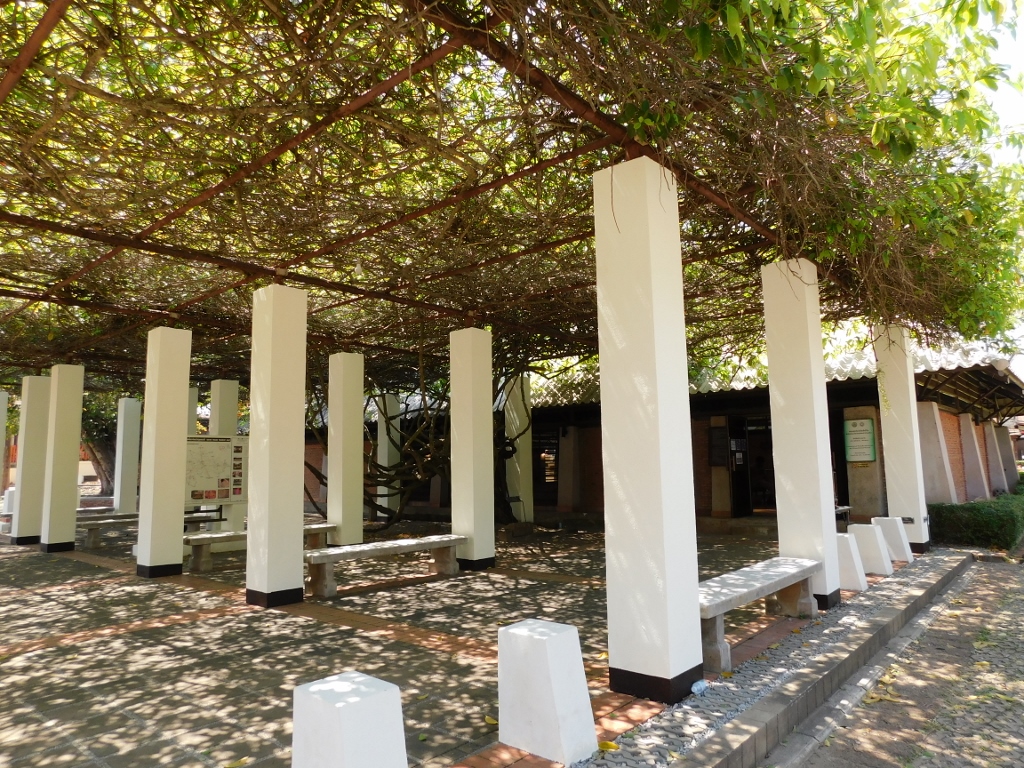 Archaeological site in Ban Chiang village
Archaeological site in Ban Chiang village
The site is organised in such a way that a structure has been erected above the excavated and preserved pit. This structure not only protects the archaeological site, but also serves as a space with exhibition areas.
 Archaeological site in Ban Chiang village
Archaeological site in Ban Chiang village
This is the only one among several excavation sites that hasn’t been either built over or simply swallowed by the expansion of the village. Moreover, it is the largest burial site excavated in Ban Chiang.
In the centre, you can see a large pit with representations of the exact arrangement where the human skeletons of a total of 52 individuals were found, along with numerous ceramic vessels and other items buried with them. Because of the possible seasonal floods, what can be seen here are only replicas, while the originals are housed in the museum and museum storage.
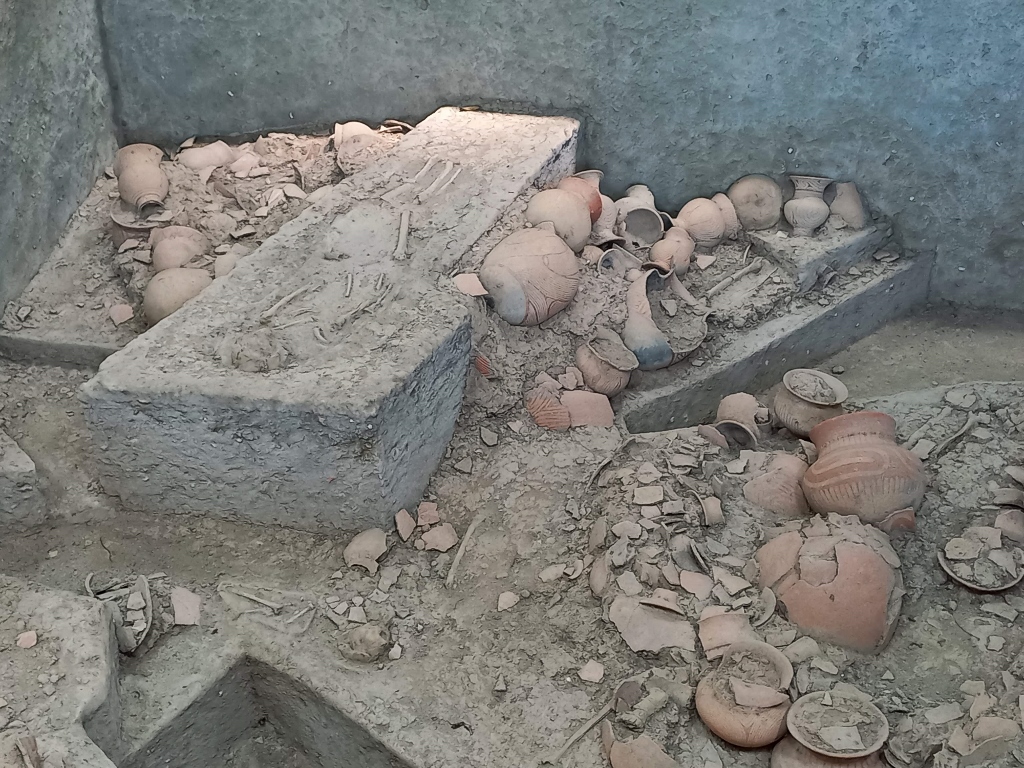 Archaeological site in Ban Chiang village, a detail
Archaeological site in Ban Chiang village, a detail
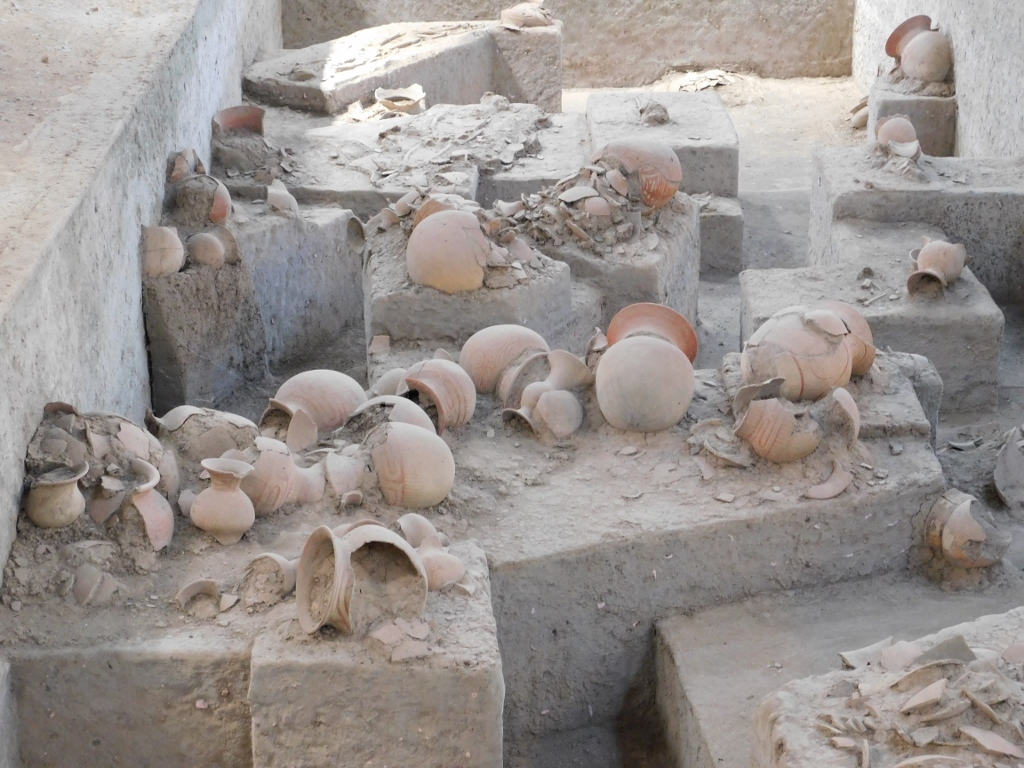 Archaeological site in Ban Chiang village, a detail
Archaeological site in Ban Chiang village, a detail
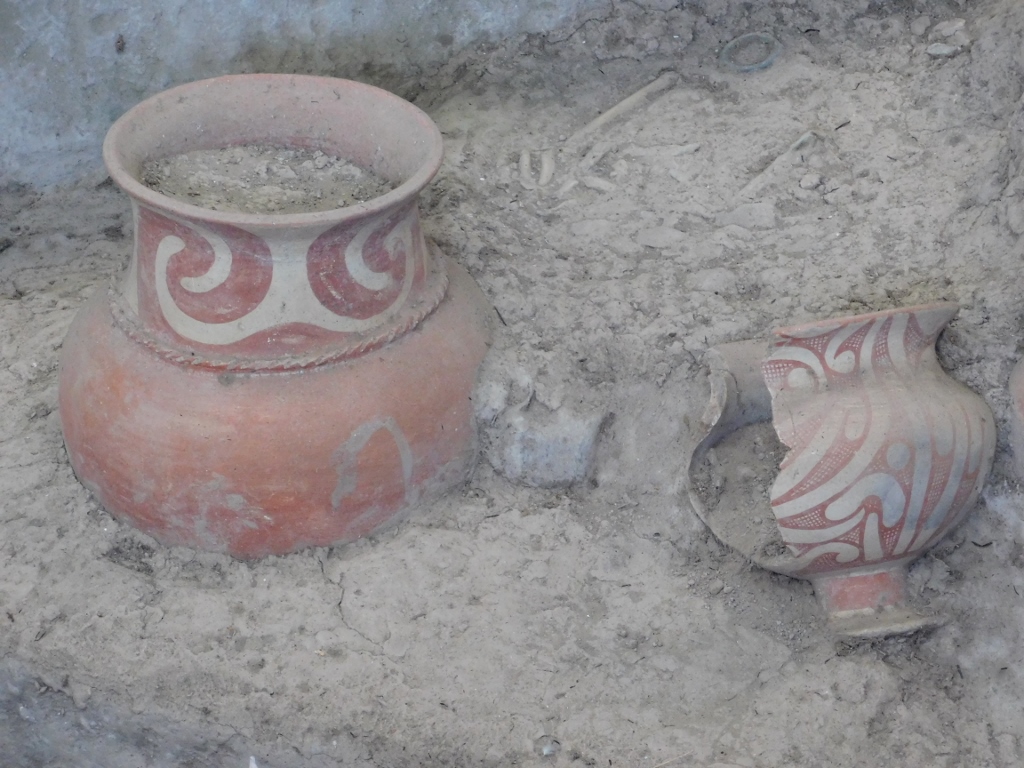 Archaeological site in Ban Chiang village, a detail
Archaeological site in Ban Chiang village, a detail
In addition to informational plaques, there are also some exhibited items around the pit that were found there. Once again, the main focus is on ceramic artefacts.
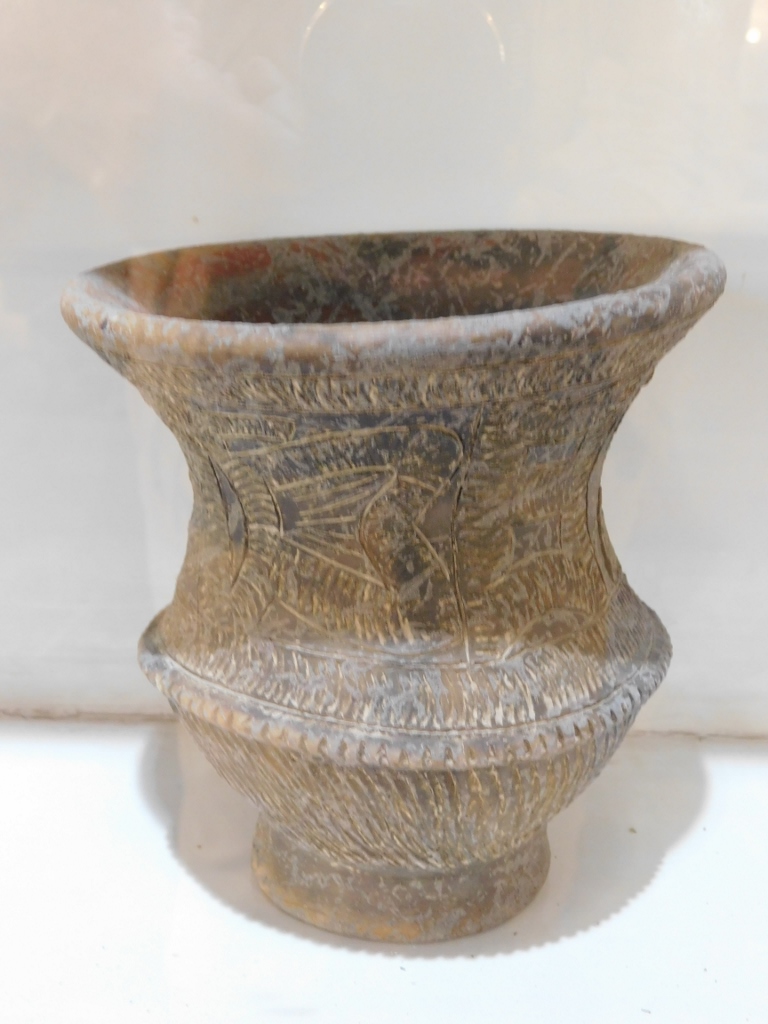 Archaeological site in Ban Chiang village, a detail
Archaeological site in Ban Chiang village, a detail
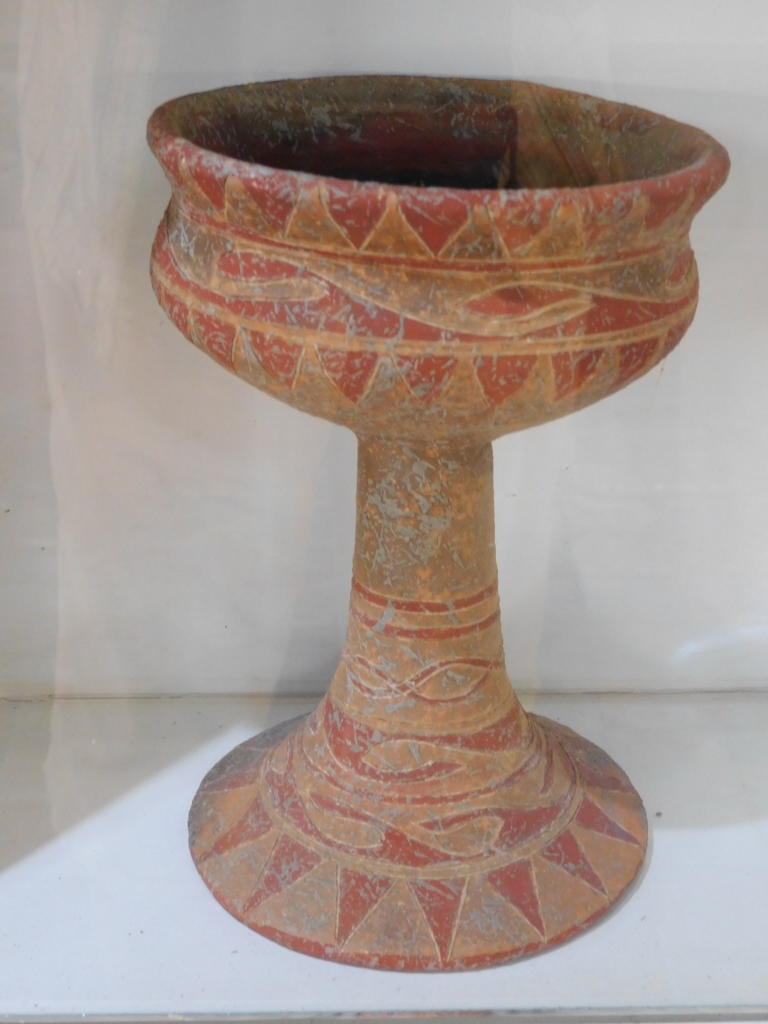 Archaeological site in Ban Chiang village, a detail
Archaeological site in Ban Chiang village, a detail
Several metal artefacts are also exhibited, as the production of bronze functioned here since around 2000 BCE, while iron objects began to be crafted in the middle of the first millennium BCE.
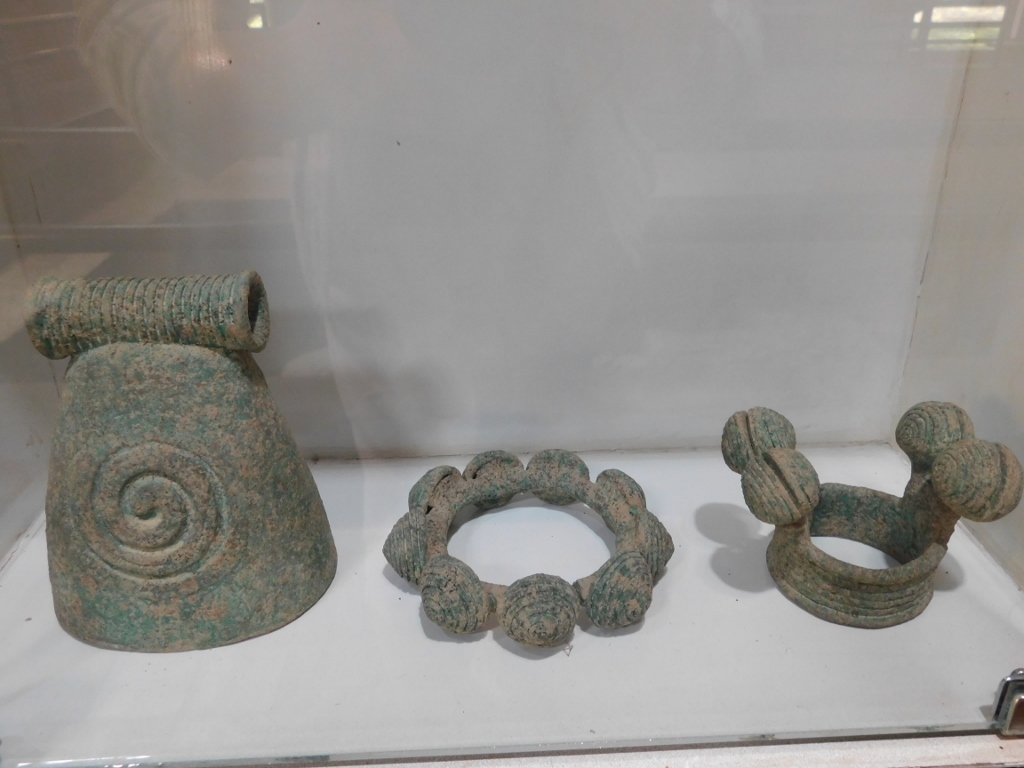 Archaeological site in Ban Chiang village, a detail
Archaeological site in Ban Chiang village, a detail
After exploring this small area, I went outside and then took a stroll around the temple complex of Wat Pho Sri Nai. The temple was initially built in 1847 at a different location, but was later relocated here. One striking structure stands out with its incredible pink and red colours.
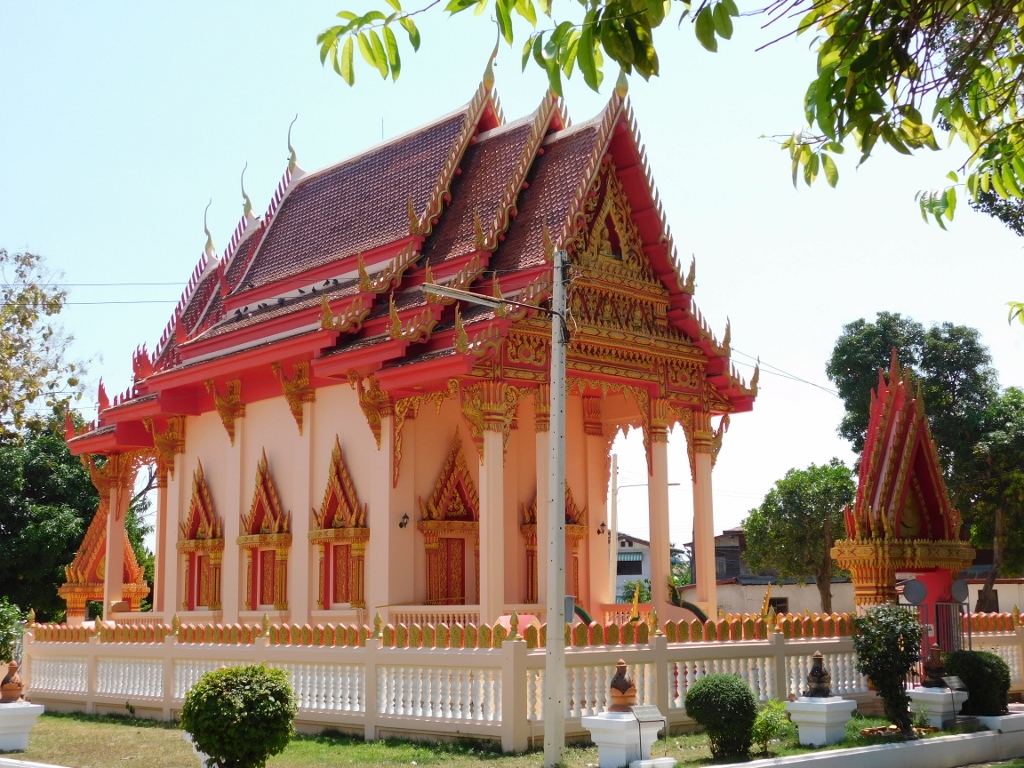 Ban Chiang village, Wat Pho Sri Nai temple
Ban Chiang village, Wat Pho Sri Nai temple
Now, I started to make my way back to the car, so I walked again along one of the main streets in the village. This time, I paid attention to various houses I passed by. It is quite evident from the way they are constructed that serious floods are a seasonal occurrence in this area.
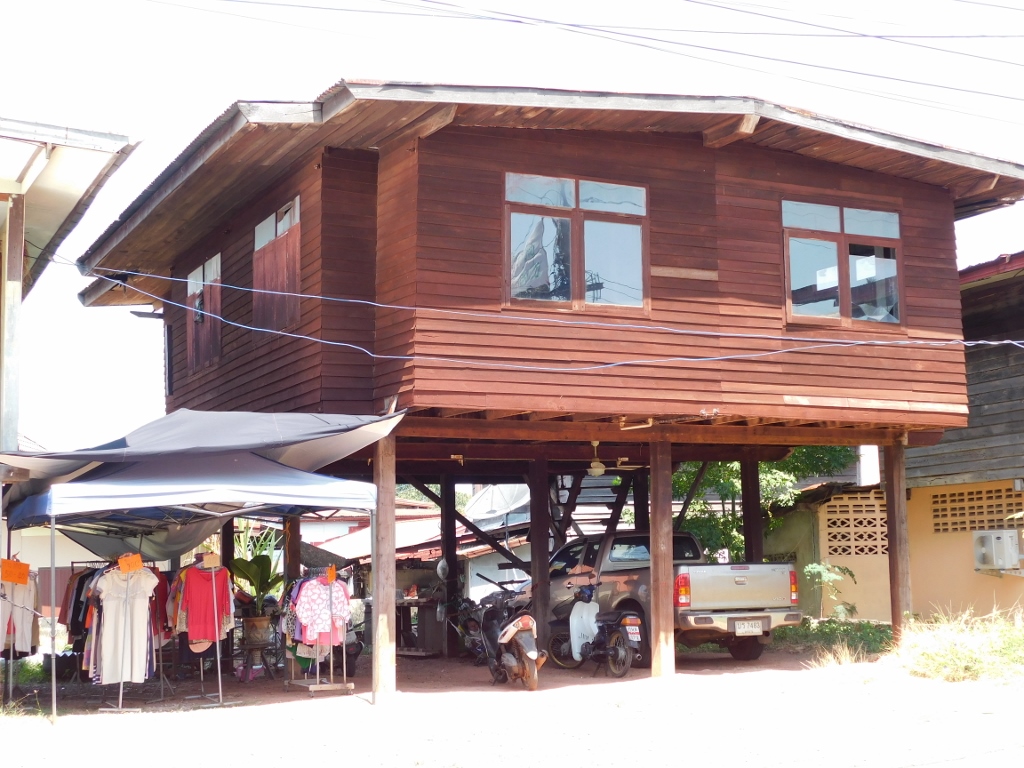 Ban Chiang village, a detail
Ban Chiang village, a detail
One of the houses had a particularly ornate gate, although the house itself was also quite impressive.
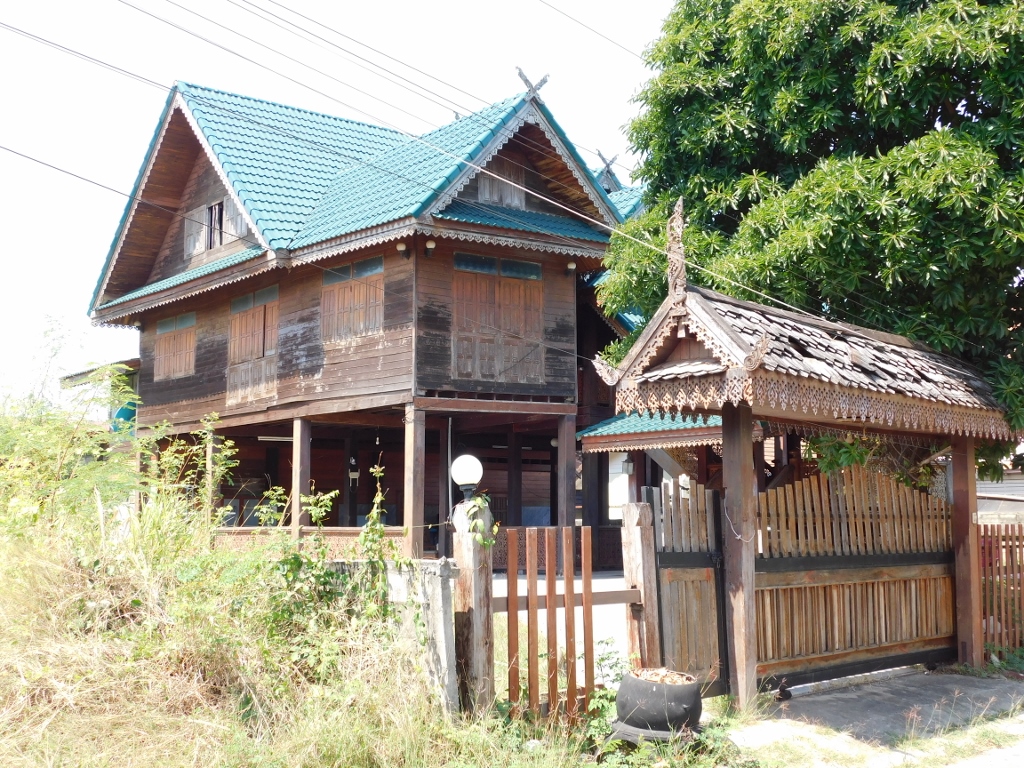 Ban Chiang village, a detail
Ban Chiang village, a detail
What caught my eye along the way were locally produced and sold brooms. Although later during my travels, I saw that this “model” of broom is not typical only for north-eastern Thailand but practically for the entire country, it was here that I first became aware of it.
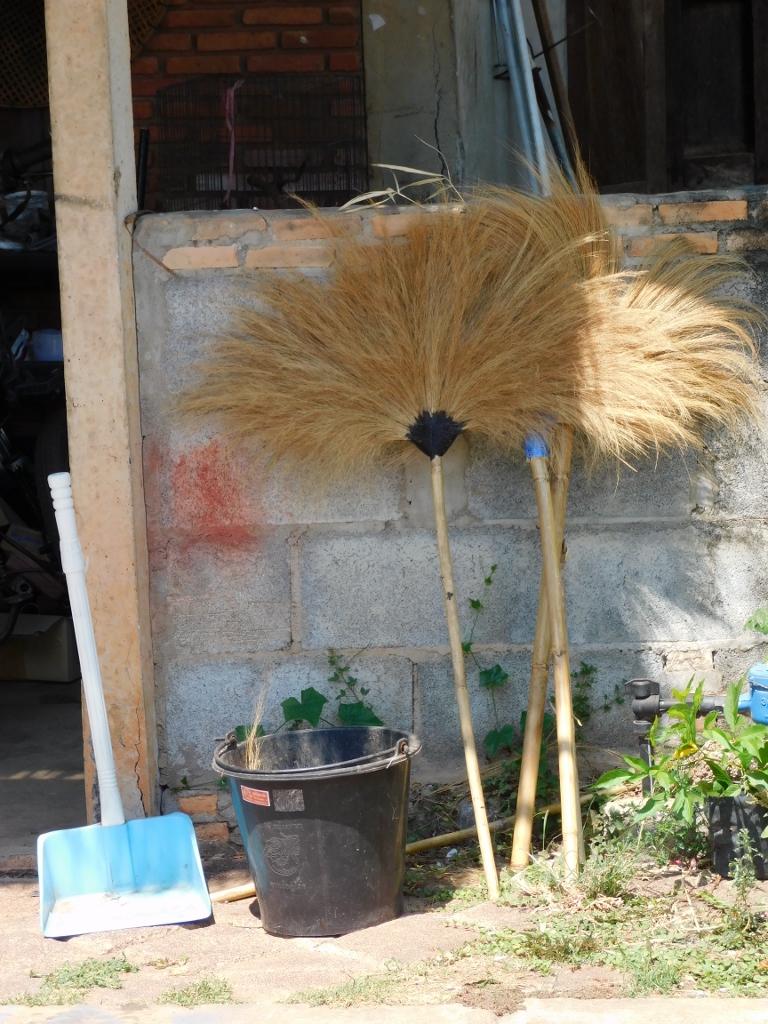 Thai broom
Thai broom
Also, in several places, I passed by sidecar motorcycles. Such vehicles are often used for transporting goods, but there are also benches in the sidecar where passengers can sit. Although I didn’t manage to capture it here, I often saw passengers sitting in the sidecar.
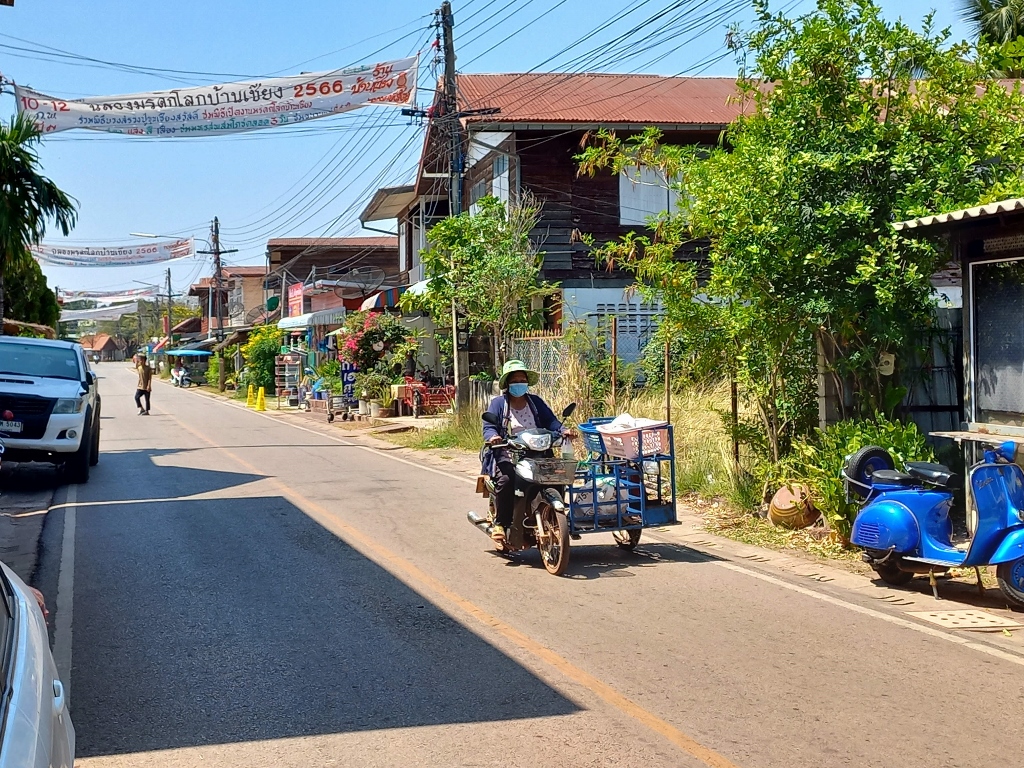 Ban Chiang village, a detail
Ban Chiang village, a detail
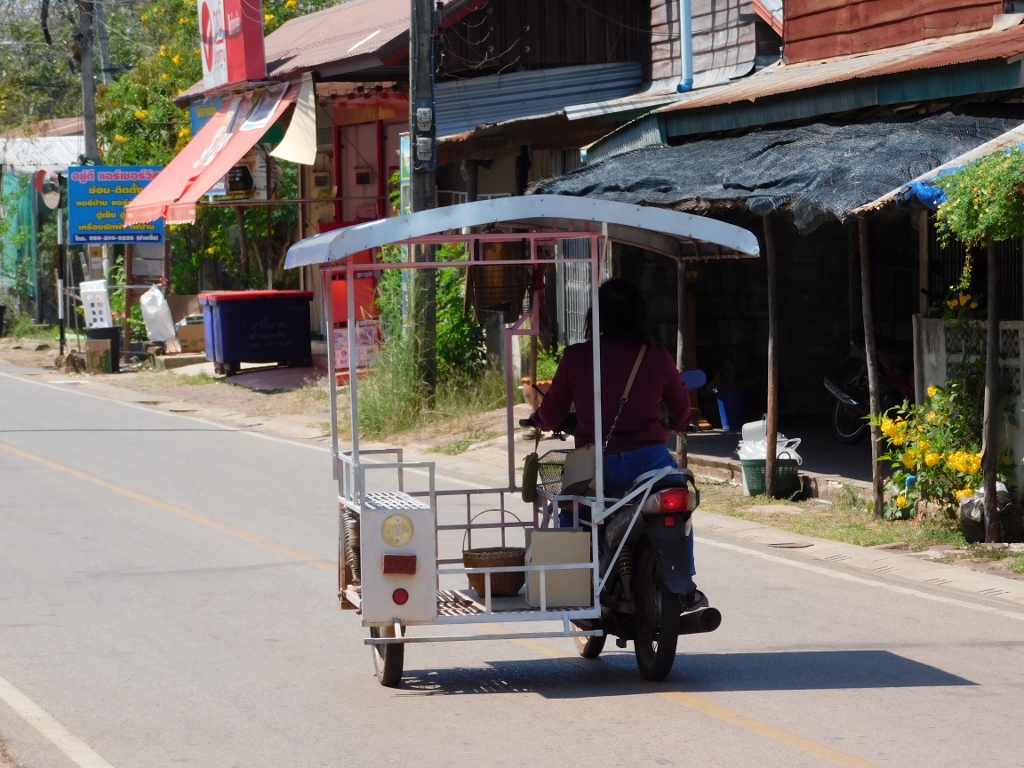 Ban Chiang village, a detail
Ban Chiang village, a detail
As a matter of pure chance, a few days before coming here, I saw that there was another temple nearby that intrigued me. Moreover, it is located only about 7.5 km north of the village of Ban Chiang and is built in the shape of a lotus. So, I couldn’t miss that.
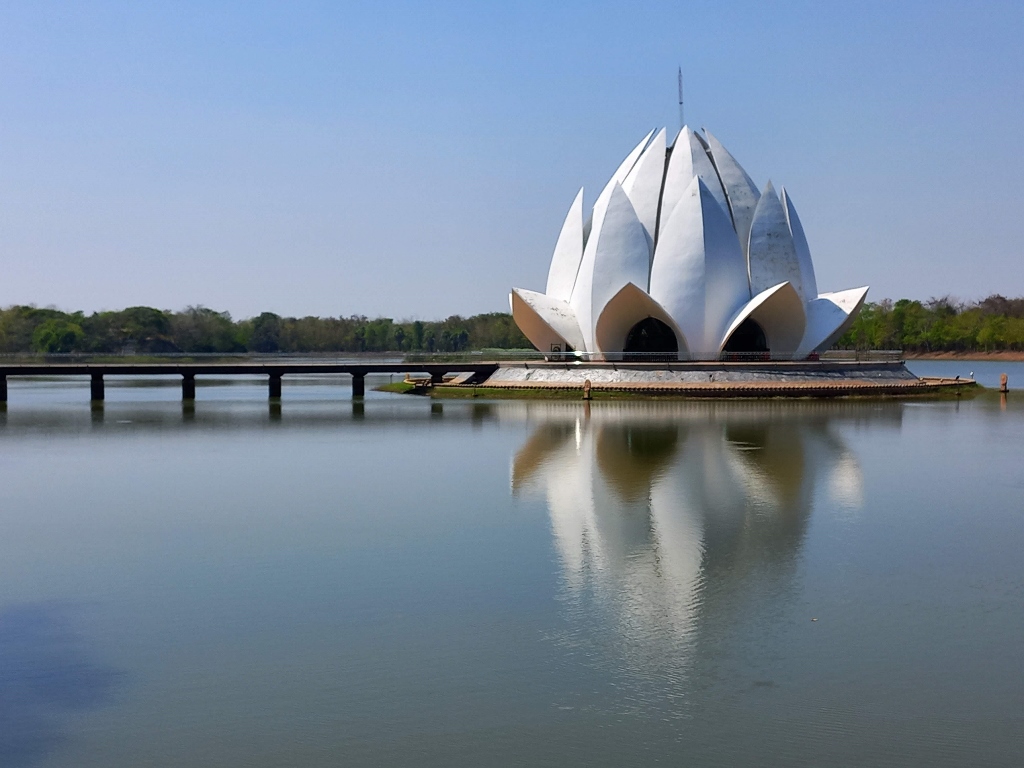 Wat Pa Dong Rai temple
Wat Pa Dong Rai temple
The temple looks absolutely enchanting and, in a way, it strongly reminded me of the Temple of Good Will in Brasília, Brazil (https://www.svudapodji.com/en/brazil-11/).
The construction of the temple began in the early 21st century and was completed in 2019, making it brand new. It is the only temple in Thailand in the shape of a lotus flower and, accordingly, it is situated in the middle of a small pond, connected to the “land” by a bridge approximately 50 meters long.
The temple is also referred to as Wat Santi Wanaram, and I must admit that it’s unclear to me why both names can be used when searching for the temple online. In any case, I’ll use the one that seems to be more commonly used.
But first, you have to approach the temple from the parking area.
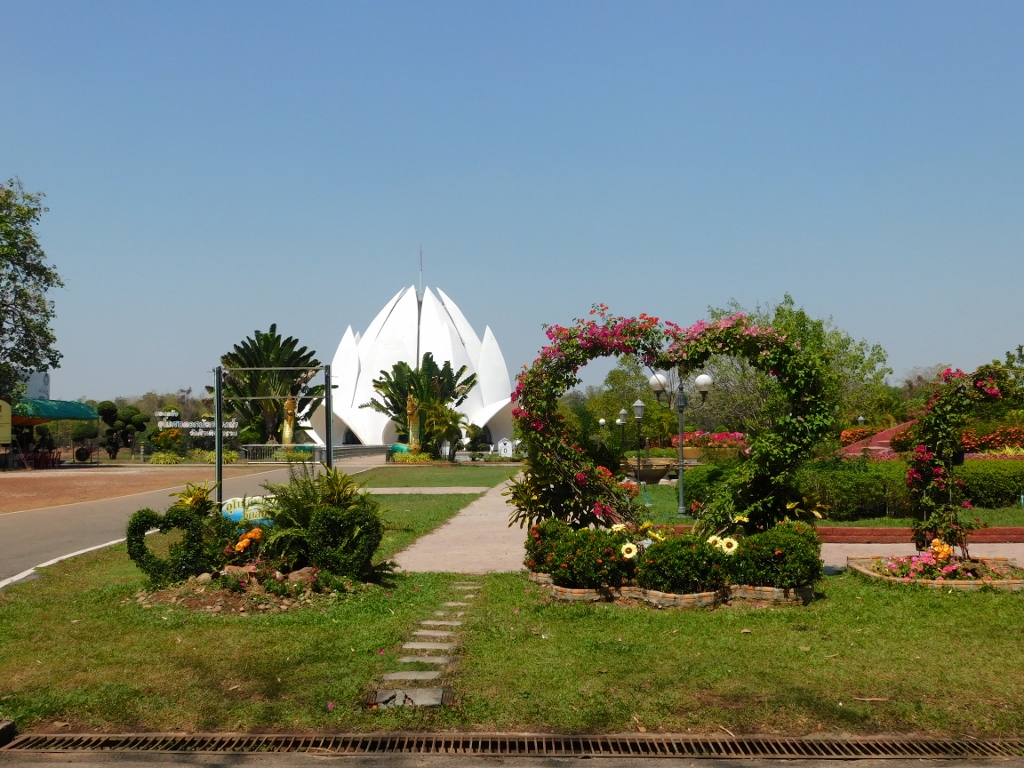 Wat Pa Dong Rai temple
Wat Pa Dong Rai temple
Before the bridge itself, you can see mythical serpent guardians, known as nagas, which serve as protectors of the bridge. Behind them stand lush traveller’s palms (Ravenala madagascariensis), as if guarding their backs, and then you proceed onto the bridge.
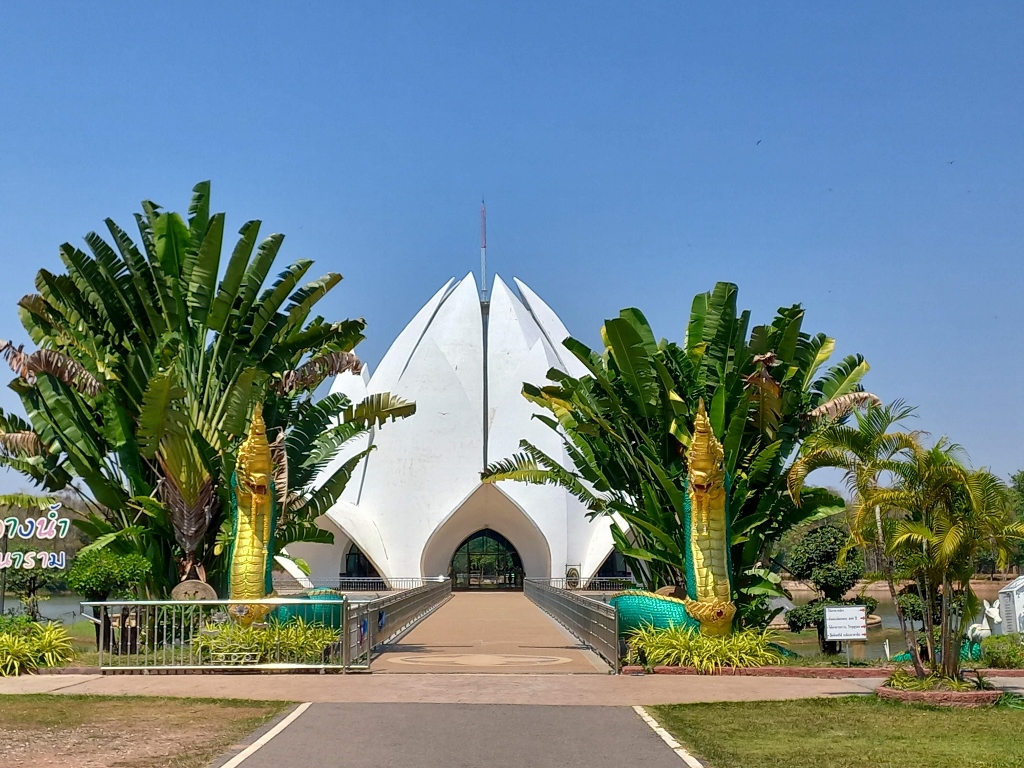 Wat Pa Dong Rai temple
Wat Pa Dong Rai temple
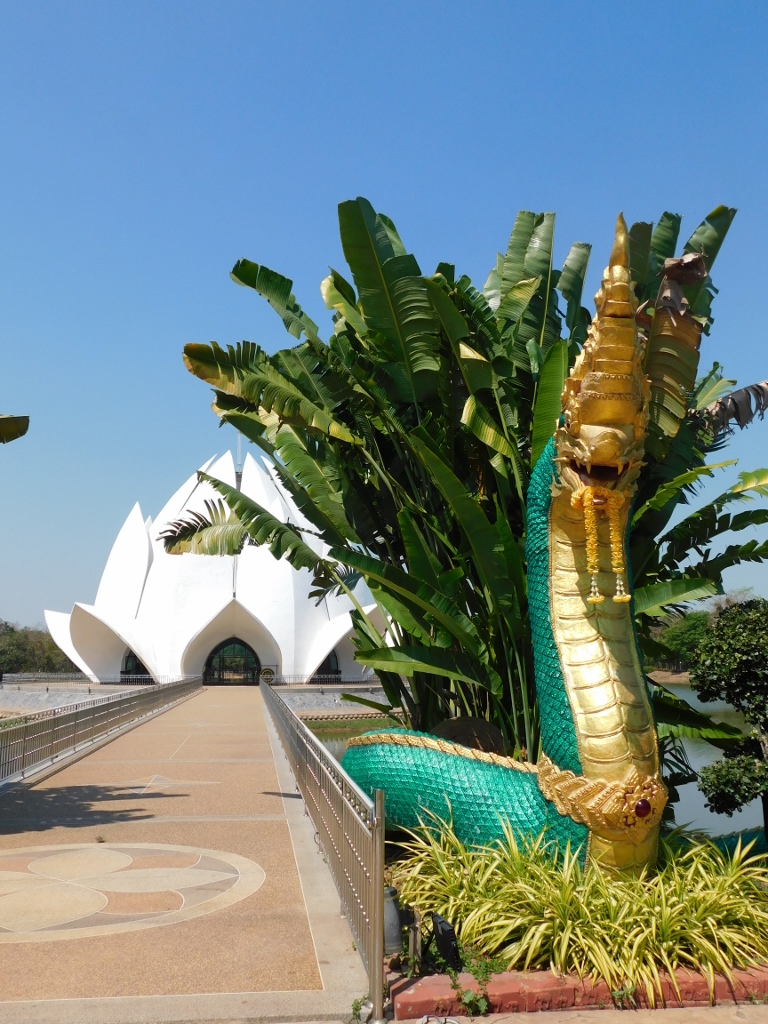 Wat Pa Dong Rai temple
Wat Pa Dong Rai temple
The sight (and the site) is spectacular!
 Wat Pa Dong Rai temple
Wat Pa Dong Rai temple
I have mentioned the important symbolism of the lotus flower in Buddhism on several occasions before. The lotus plant starts to grow from the mud, breaking through the murky swamp waters and, eventually, on the surface, it blossoms into a beautiful flower that leaves behind all impurities from which it originated and through which it grew. Symbolically, this represents our lives and our task is to achieve enlightenment and rise above the mire of our own existence.
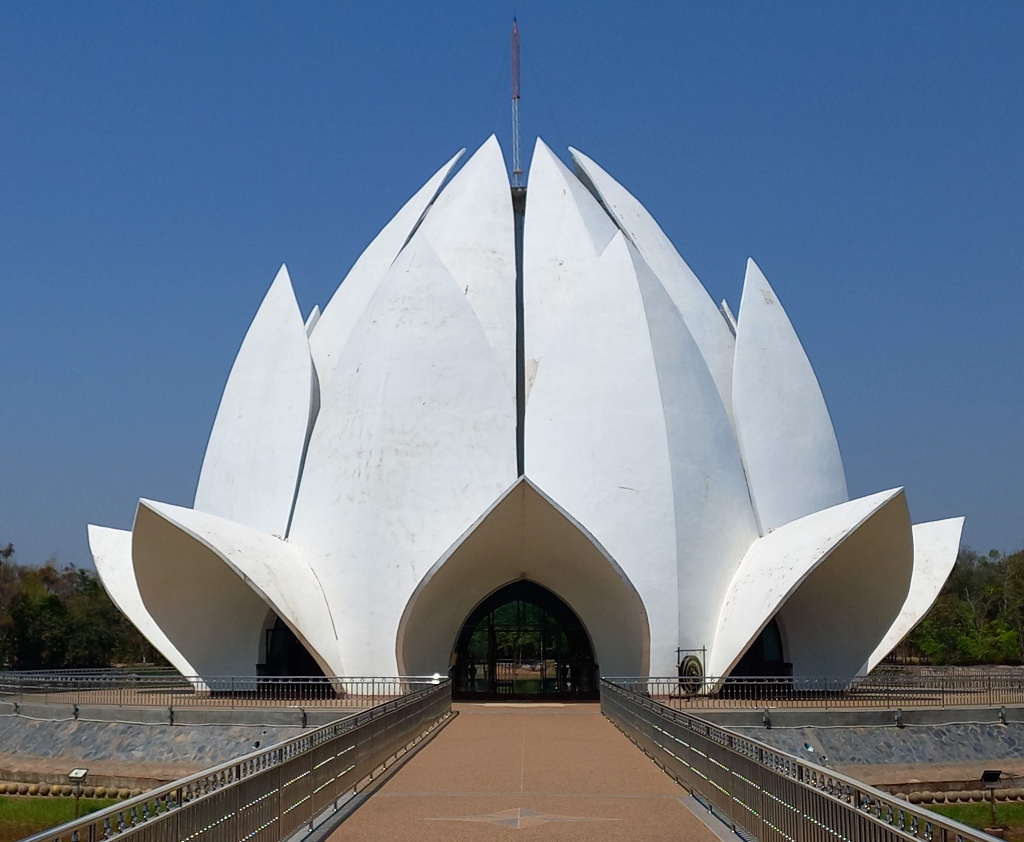 Wat Pa Dong Rai temple
Wat Pa Dong Rai temple
The white lotus specifically symbolises purity and is often mentioned to symbolise the rising above desires and attachments, ultimately leading to the enlightenment.
This concrete “flower” is about 20 metres tall, but the ceiling height inside doesn’t reach such heights.
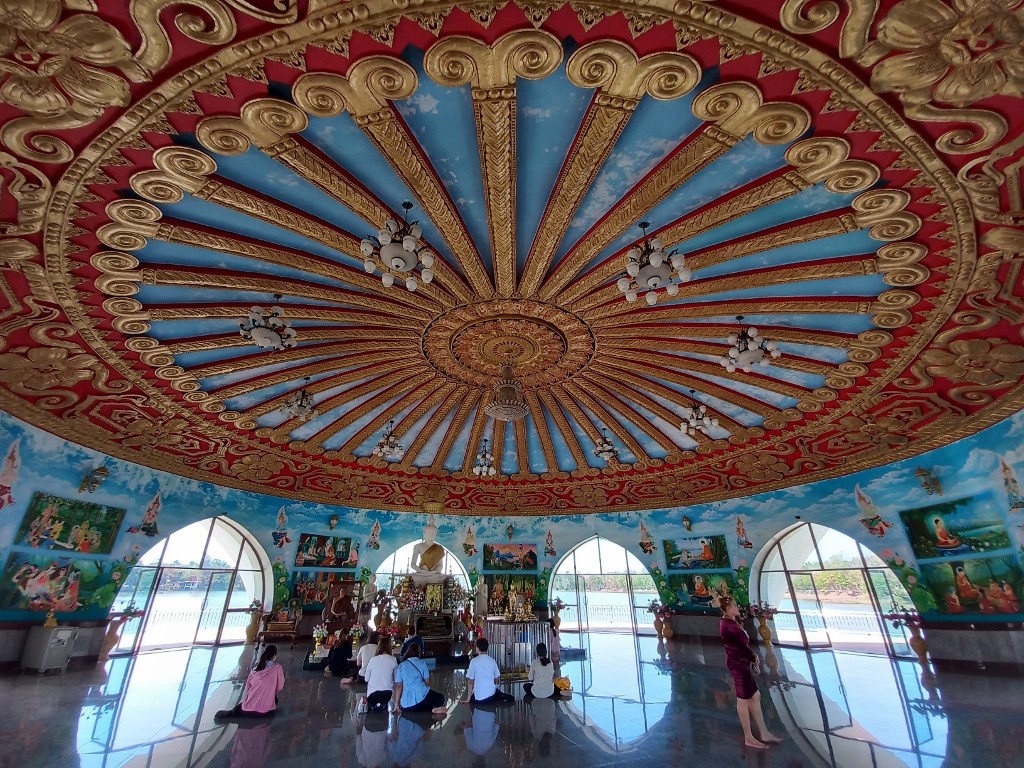 Wat Pa Dong Rai temple, the interior
Wat Pa Dong Rai temple, the interior
The interior of the temple is richly decorated and, on the walls, you can see paintings depicting details related to the life of the Buddha.
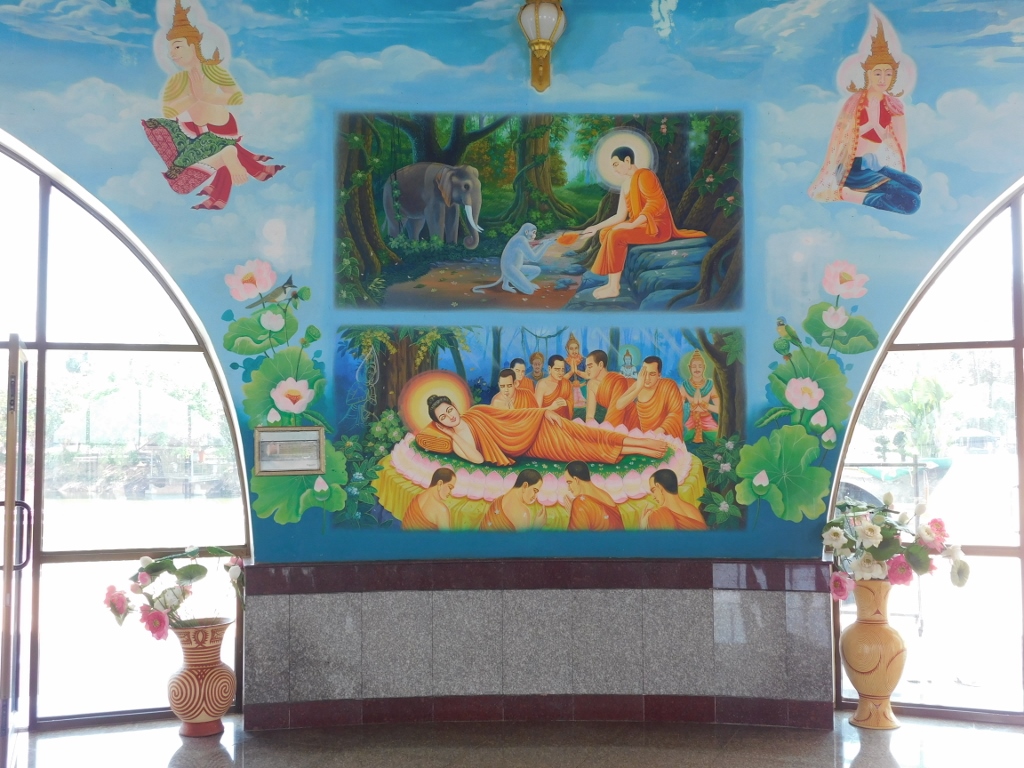 Wat Pa Dong Rai temple, the interior
Wat Pa Dong Rai temple, the interior
I also made a short video here:
After a short sightseeing of the temple’s interior, I stepped outside and then walked along the terrace surrounding the temple. There, I noticed upright stone sculptures that I presume are sema stones. These stones are highly significant in the Thai sacred architecture, placed at the corners of temples to mark clearly the enclosed space as sacred. I’m not certain if that’s the case here, but they looked beautiful nonetheless.
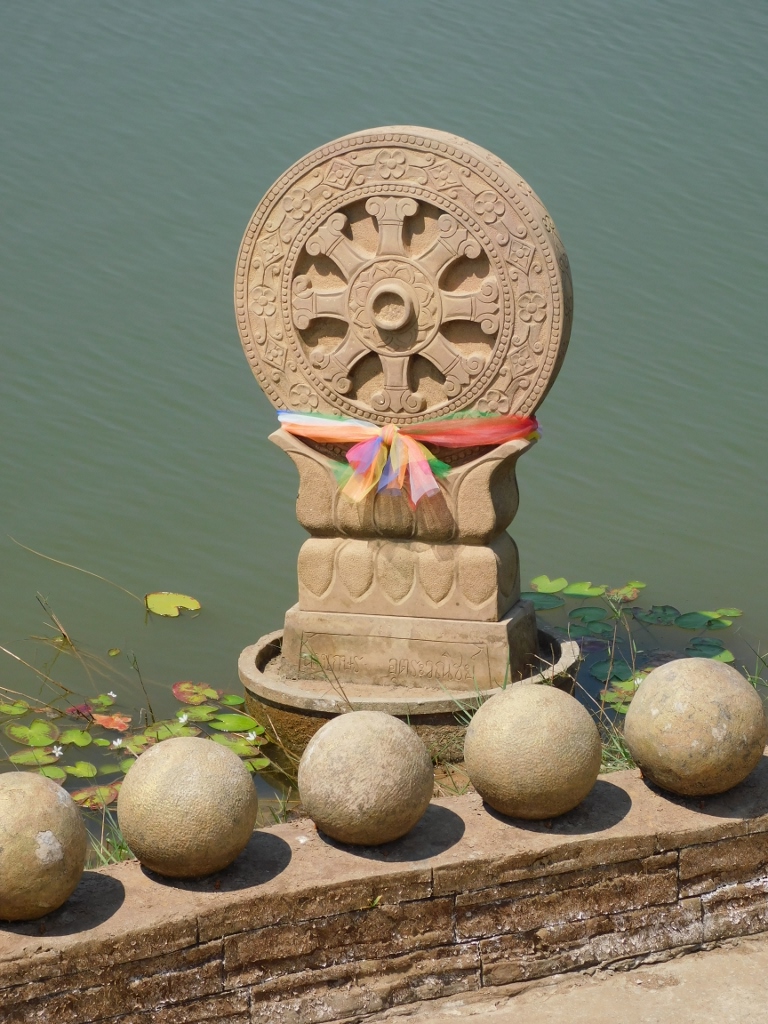 Wat Pa Dong Rai temple, a detail
Wat Pa Dong Rai temple, a detail
Returning later to the pond’s shore, I noticed an interesting bird – the Javan pond-heron (Ardeola speciosa).
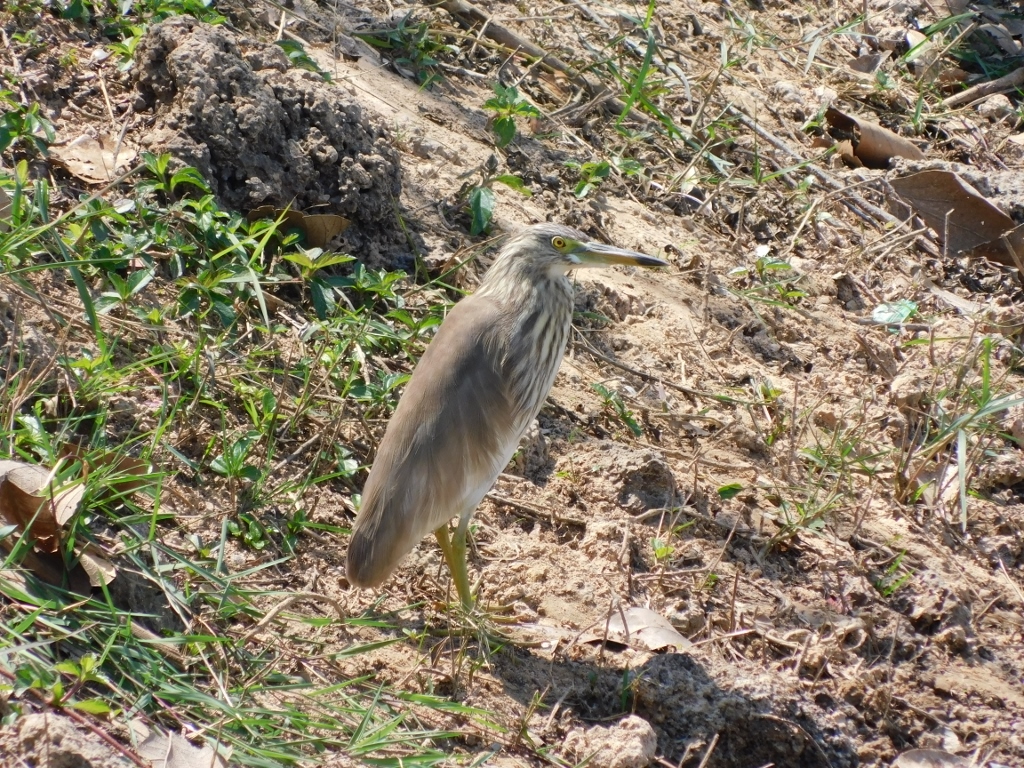 Javan pond-heron
Javan pond-heron
I also came across information that there are crocodiles in the pond or some part of it within the temple complex, but I didn’t see them. What I did see at one point was a multitude of fish being fed by a girl from a terrace above the pond.
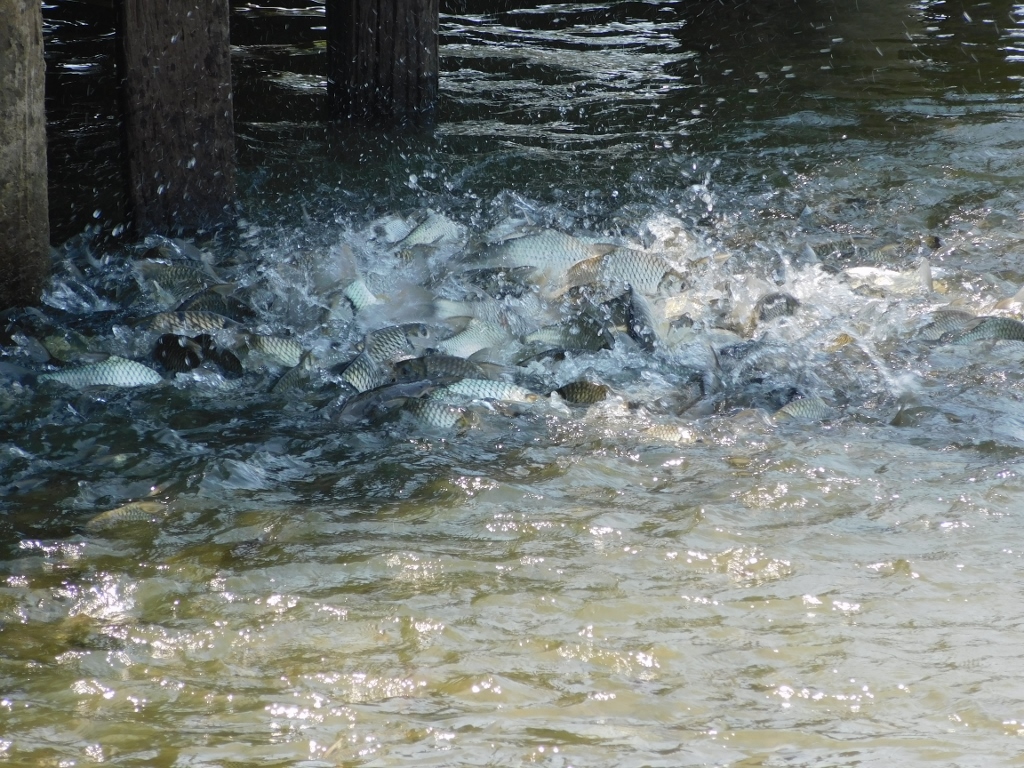 Feeding frenzy
Feeding frenzy